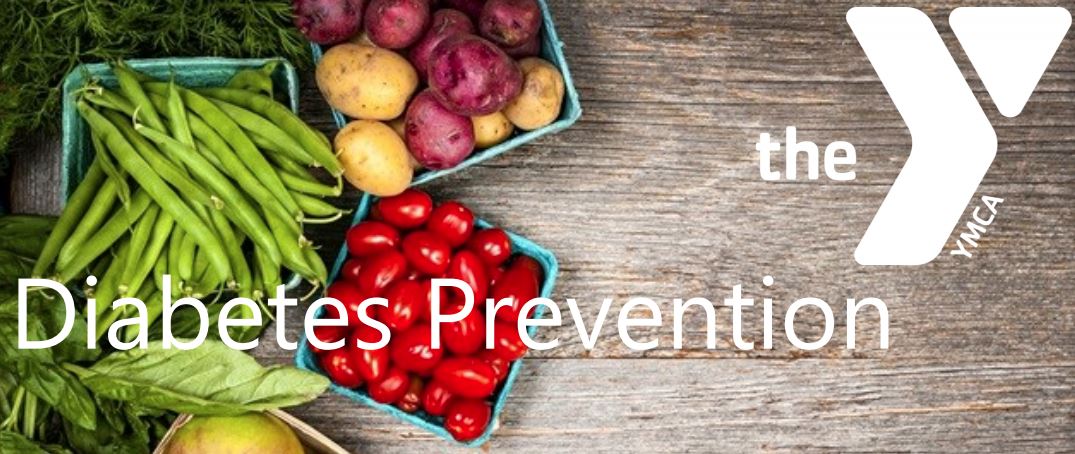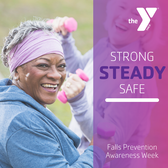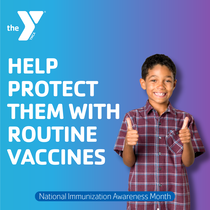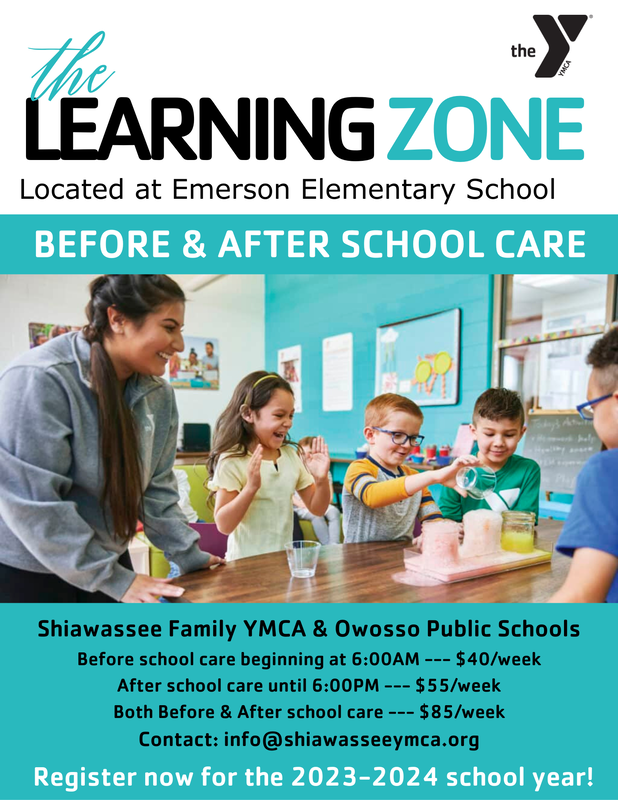 Did you know that arthritis impacts more than 50 million Americans, making it the number one cause of disability in the country? The Shiawassee Family YMCA is here to help, with an evidence-based arthritis management program called Enhance®Fitness, designed for those with arthritis. This program features simple, easy-to-learn movements that motivate individuals (particularly those with arthritis) to stay active and reclaim their health. Some changes that participants have noticed:
Enhance®Fitness is offered on Tuesdays and Thursdays at 12:30pm. This class is free for members.
0 Comments
 Did you know that of the 96 million Americans who have prediabetes, more than 8 in 10 adults don't know they have it? March 26 is Diabetes Alert Day, and the Shiawassee Family YMCA is encouraging Shiawassee County residents to understand their risks for prediabetes and type 2 diabetes and steps to take to prevent the disease. First, we invite you to take the 60-second test led by the Centers for Disease Control and Prevention (CDC), the American Medical Association and the Ad Council to find out if you're at risk: doihaveprediabetes.org. Next, we are sharing a handful of lifestyle changes that contribute to weight loss, and healthy living can decrease the risk for type 2: Talk to Your Doctor Use this moment as a reminder to talk to your health care provider about your diabetes risk factors. This is especially true if you have a family history or are overweight. More Fruits and Veggies Try incorporating more fruits and vegetables into your day! Eating a colorful array of healthy foods can have a huge impact on your overall health. There are some great recipes available including vegetables that are in season this time of year - get creative in the kitchen! More Lean Proteins Basic lifestyle changes - such as choosing fish, lean meats and poultry without skin - can contribute to weight loss and decrease the risk for type 2 diabetes. Check out some healthy and delicious ways to prepare these proteins at diabetes.org/. Grain Power There's power in grain! Aim for whole grains with every meal. A whole grain sandwich filled with fresh veggies and lean meat is both filling and delicious. 150 Minutes of Movement Small steps matter. Build up to 150 minutes of physical activity per week. You can start with a simple walk each day or check out our Y's exciting group fitness class schedule. The key is to just keep moving! Drink More Water Basic lifestyle changes, like drinking water instead of drinks with added sugar, can contribute to weight loss and decreases the risk for type 2 diabetes. Carrying and refilling a reusable water bottle is an easy way to keep thirst (and sugary beverage temptation!) at bay. If you're at risk of developing type 2 diabetes, there is something you can do about it. The Shiawassee Family YMCA has partnered with the Muskegon YMCA to offer the YMCA's Diabetes Prevention Program which helps participants achieve healthy eating, regular physical activity, and modest weight loss—all of which have been shown to reduce the risk of developing type 2 diabetes. Learn more: muskegonymca.org/diabetes-prevention/. February is American Heart Month, and with recently published research indicating blood pressure control has worsened in both men and women since the onset of the COVID-19 pandemic, it's important to use this month to get a blood pressure screening and focus on becoming heart healthy. Below are tips for everyone to become heart healthy this February.
Many people associate the Y with basketball, treadmills, or even a place to enjoy a cup of coffee. But the true power of the Y isn't found within four walls. The Y is in the hearts and actions of every neighbor who believes in our vision of a better "us" and a stronger community for all.
Thanks to the support of neighbors like you, this year we have:
Did you know that of the 88 million Americans who have prediabetes, less than 16 percent are aware they have it? November is National Diabetes Awareness Month, and the Shiawassee Family YMCA is encouraging Shiawassee County residents to understand their risks for prediabetes and type 2 diabetes and steps to take to prevent the disease.
First, we invite you to take the 60-second American Diabetes Association's risk test to find out if you're at risk: https://diabetes.org/diabetes/risk-test. Next, we are sharing a handful of lifestyle changes that contribute to weight loss, and healthy living can decrease the risk for type 2: Talk to Your Doctor Use this moment as a reminder to talk to your health care provider about your diabetes risk factors. This is especially true if you have a family history or are overweight. More Fruits and Veggies Try incorporating more fruits and vegetables into your day! Eating a colorful array of healthy foods can have a huge impact on your overall health. There are some great fall recipes available including vegetables that are in season this time of year—get creative in the kitchen! More Lean Proteins Basic lifestyle changes—such as choosing fish, lean meats and poultry without skin— can contribute to weight loss and decrease the risk for type 2 diabetes. Check out some healthy and delicious ways to prepare these proteins at diabetes.org/. Grain Power There's power in grain! Aim for whole grains with every meal. A whole grain sandwich filled with fresh veggies and lean meat is both filling and delicious. 150 Minutes of Movement Small steps matter. Build up to 150 minutes of physical activity per week. You can start with a simple walk each day or check out our Y's exciting group fitness class schedule. The key is to just keep moving! Drink More Water Basic lifestyle changes, like drinking water instead of drinks with added sugar, can contribute to weight loss and decreases the risk for type 2 diabetes. Carrying and refilling a reusable water bottle is an easy way to keep thirst (and sugary beverage temptation!) at bay. October is Family Health Month, and the Shiawassee Family YMCA is dedicated to supporting all families as they work to create healthier lifestyles for themselves and all of their loved ones. Check out these five easy ways you can create a healthier household today!
Eat Healthy As you gather for meals, be mindful of the nutritional choices you make. The Y encourages a well-balanced diet, and you can get started with small, gradual changes! Check out this USDA healthy eating tip sheet, which is a great starting point towards planning healthier meals for your family. Daily Play Put down the electronics and find time to play! Children need varying levels of physical activity each day depending on their age, so be sure to encourage play time. And when in doubt, the Y is here to help - we offer a wide variety of youth activities and group exercise classes - something for the entire family! Visit our website to learn more! Together Time Relationships are the heart of a healthy family. Prioritize quality time together - whether that's catching up over dinner, playing a board game or chatting about your day while out for a family stroll. These shared moments are what keep your relationship strong. Get Outdoors Great things happen in the great outdoors - make your time outside a family affair! Unplugging and enjoying nature is good for the body and mind. Make time for family park trips, hikes or simply taking your furry four-legged friend on a walk together. Prioritize Sleep After all this physical activity and mental stimulation - remember to get some well-deserved rest! Getting a good night's sleep is beneficial both physically and mentally. Make sure you and all the members of your family are getting the recommended amount of sleep each night.  Falls Prevention Awareness Week is September 18-22. Falls are the leading cause of injury related ER visits for older adults, the major cause of hip fractures and responsible for more than half of fatal head injuries. Below, the National Council on Aging shares 10 myths related to older adult falls. After exploring these myths, the Shiawassee Family YMCA wants to remind you that we are here to help! Our Moving for Better Balance class is an evidence-based program that works to improve balance, muscle strength, flexibility and more. Myth 1: Falling happens to other people, not to me. Reality: Many people think, "It won't happen to me." But the truth is that 1 in 4 older adults fall every year in the U.S. Myth 2: Falling is something normal that happens as you get older. Reality: Falling is not a normal part of aging. Strength and balance exercises, managing your medications, having your vision checked and making your living environment safer are all steps you can take to prevent a fall. Myth 3: If I limit my activity, I won't fall. Reality: Some people believe that the best way to prevent falls is to stay at home and limit activity. Not true. Performing physical activities will help you stay independent, as your strength and range of motion benefit from remaining active. Social activities are also good for your overall health. Myth 4: If I stay home, I can avoid falling. Reality: Over half of all falls take place at home. Inspect your home for fall risks. Fix simple but serious hazards such as clutter, throw rugs and poor lighting. Make simple home modifications, such as adding grab bars in the bathroom, a second handrail on stairs and non-slip paint on outdoor steps. Myth 5: Muscle strength and flexibility can't be regained. Reality: While we do lose muscle as we age, exercise can partially restore strength and flexibility. It's never too late to start an exercise program. Even if you've been a "couch potato" your whole life, becoming active now will benefit you in many ways—including protection from falls. Myth 6: Taking medication doesn't increase my risk of falling. Reality: Taking any medication may increase your risk of falling. Medications affect people in many ways and can sometimes make you dizzy or sleepy. Be careful when starting a new medication. Talk to your health care provider about potential side effects or interactions of your medications. Myth 7: I don't need to get my vision checked every year. Reality: Vision is another key risk factor for falls. Aging is associated with some forms of vision loss that increase the risk of falling and injury. People with vision problems are more than twice as likely to fall as those without visual impairment. Have your eyes checked at lest once a year and update your eyeglasses. For those with low vision there are programs and assistive devices that can help. Ask your optometrist for a referral. Myth 8: Using a walker or can will make me more dependent. Reality: Walking aids are very important in helping many older adults maintain or improve their mobility. However, make sure you use these devices safely. Have a physical therapist fit the walker or cane to you and instruct you in its safe use.Myth 9: I don’t need to talk to family members or my health care provider if I’m concerned about my risk of falling. I don’t want to alarm them, and I want to keep my independence. Reality: Fall prevention is a team effort. Bring it up with your doctor, family and anyone else who can help. They want to help you maintain your mobility and reduce your risk of falling. Myth 10: I don’t need to talk to my parents, spouse, or other older adults if I’m concerned about their risk of falling. It will hurt their feelings, and it's none of my business. Reality: Let them know about your concerns and offer support to help them maintain the highest degree of independence possible. There are many things you can do, including removing hazards in the home, installing safety features like grab bars or walk-in bathtubs, finding a falls prevention program at the Y or setting up a vision exam. September is Childhood Obesity Awareness Month, and as children and families start their new school-year routines, it's a perfect time to reflect and refresh your family's healthy habits. As families settle into new school-year routines this month, the Shiawassee Family YMCA is offering tips to help Shiawassee County families incorporate healthy eating and physical activity into their lives.
 August is National Immunization Awareness Month. This annual observance highlights the importance of getting recommended vaccines throughout your life. As a community serving organization, the Shiawassee Family YMCA wants to remind you of the importance of routine vaccinations. During the month of August, we encourage you to talk to your doctor, nurse or healthcare provider to ensure you and your family are protected against serious diseases by getting caught up on routine vaccinations. As your children head back to school this fall, it's particularly important for you to work with your child's doctor or nurse to make sure they get caught up on missed well-child visits and recommended vaccines. Remember to take care of yourself, too! Make sure you receive any vaccines you need to stay healthy. Use CDC's adult vaccine assessment tool to see which vaccines might be right for you. For more information on routine vaccinations at any stage in life, visit cdc.gov/vaccines. As another summer winds down and a new school year is on the horizon, the Shiawassee Family YMCA wants to remind parents and caregivers that the Y's before & after school care programs are a place where children can remain active and engaged during their time out of school — a critical time for all school-age children. Below, we've listed five reasons your child should get involved with Y before & after school care once school starts!
Physical Activity The Y's after school programs combine learning with play. Each day, we provide physical activity which is vital to the overall health and wellbeing of every child in our program. Some physical activities include playground time, organized fitness activities, and a variety of sports. Healthy Eating Habits Teaching children the importance of nutrition and healthy eating is key to their success — both in and out of school. At Boxcar and The Learning Zone, we ensure that kids in our community are provided with healthy after school snacks any time they are in our care and are taught healthy eating habits. Academics, Arts & STEM The Y's before & after school programs help fill gaps in schools and communities where some academic and recreational activities may be limited. Kids can improve their study habits and reading skills; gain exposure to the arts; find a love for STEM activities and much more. Some of these activities include crafts, science experiments and language arts projects. Character Building Kids who attend Boxcar and Learning Zone demonstrate improvement in the values, skills, attitudes and behaviors needed for success in school and in life. Kids can achieve, feel a sense of belonging and explore new interests every time they attend one of our programs. Safety Standards It is vital that children have a safe, enriching environment for learning, both in and out of school. The Shiawassee Family YMCA and its partners, Durand Area Schools and Owosso Public Schools, uphold the highest level of safety standards. For more information on either of our Before & After School Care Programs, visit Durand Boxcar or The Learning Zone. |



